Cloud Computing
VerifiedAdded on 2023/01/18
|10
|2280
|86
AI Summary
This paper discusses the potential benefits and problems of virtualization in public, private, and hybrid clouds. It explores the advantages of virtualization in private clouds, such as high security and flexibility. It also examines the benefits of virtualization in public clouds, including cost-effectiveness and centralized storage. Additionally, it discusses the benefits of virtualization in hybrid clouds, such as risk elimination and flexible data transfer. However, it also highlights potential problems, such as virtualization backup and disaster recovery in private clouds, congested storage networks in public clouds, and depleted resources in hybrid clouds.
Contribute Materials
Your contribution can guide someone’s learning journey. Share your
documents today.
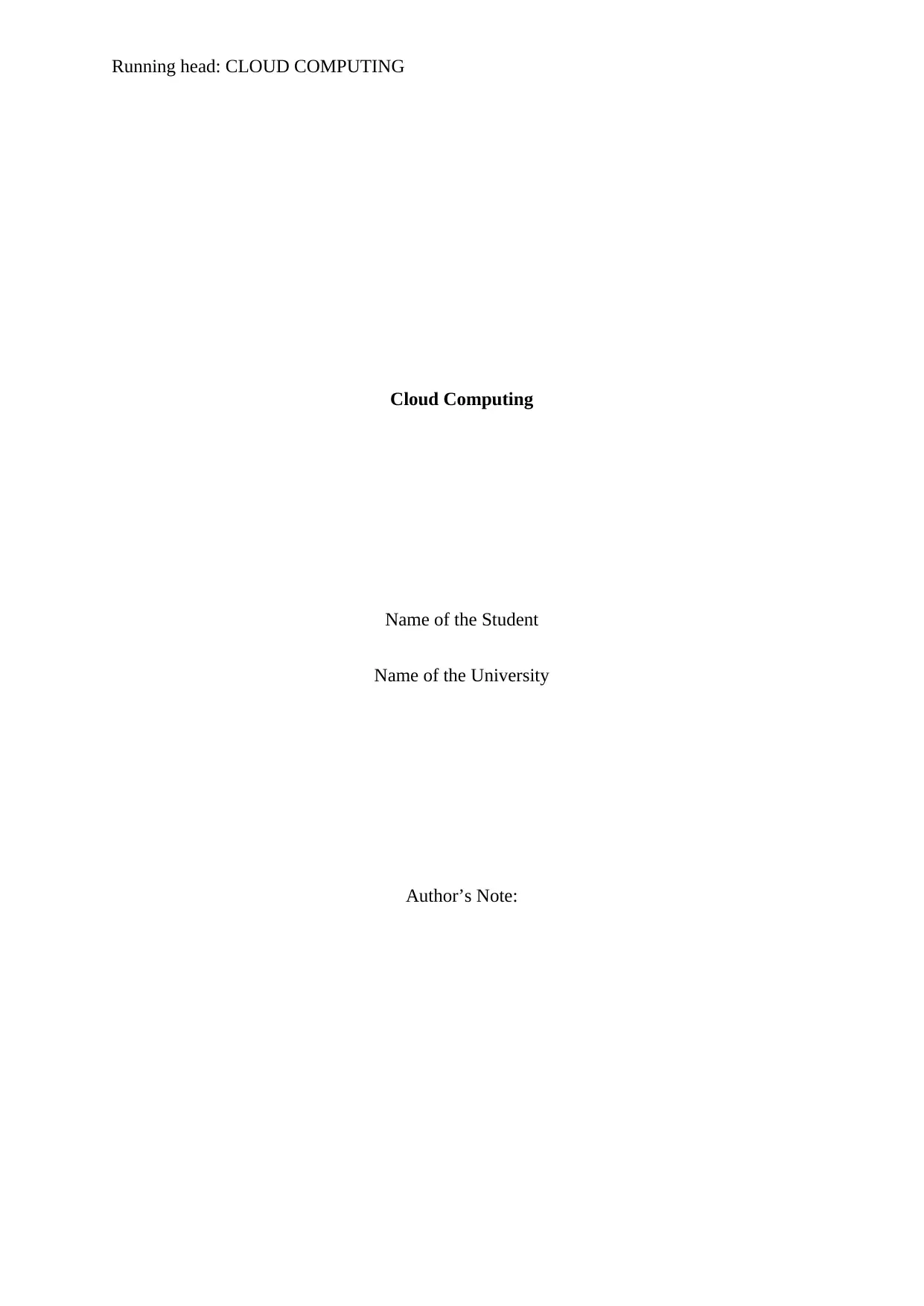
Running head: CLOUD COMPUTING
Cloud Computing
Name of the Student
Name of the University
Author’s Note:
Cloud Computing
Name of the Student
Name of the University
Author’s Note:
Secure Best Marks with AI Grader
Need help grading? Try our AI Grader for instant feedback on your assignments.
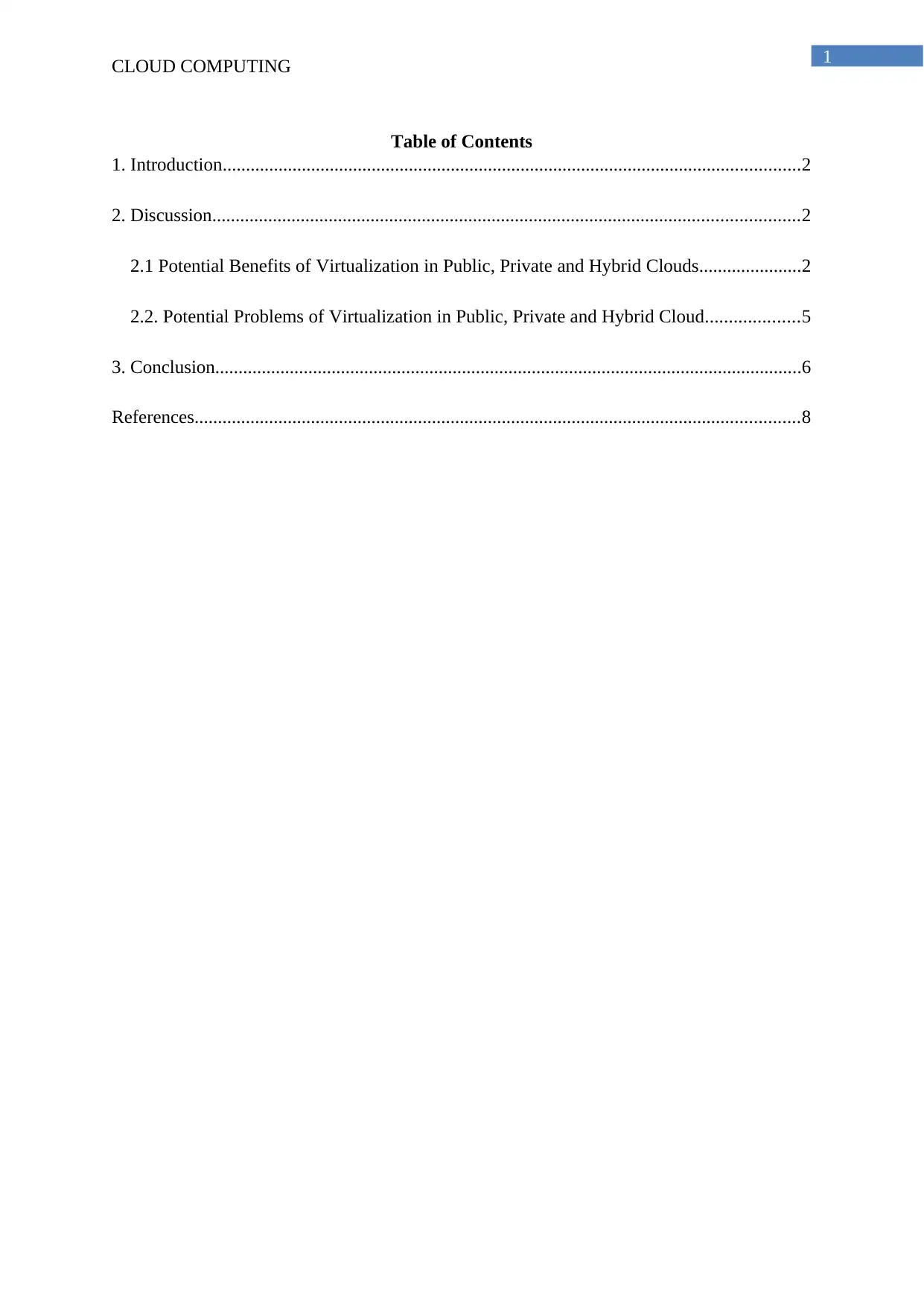
1
CLOUD COMPUTING
Table of Contents
1. Introduction............................................................................................................................2
2. Discussion..............................................................................................................................2
2.1 Potential Benefits of Virtualization in Public, Private and Hybrid Clouds......................2
2.2. Potential Problems of Virtualization in Public, Private and Hybrid Cloud....................5
3. Conclusion..............................................................................................................................6
References..................................................................................................................................8
CLOUD COMPUTING
Table of Contents
1. Introduction............................................................................................................................2
2. Discussion..............................................................................................................................2
2.1 Potential Benefits of Virtualization in Public, Private and Hybrid Clouds......................2
2.2. Potential Problems of Virtualization in Public, Private and Hybrid Cloud....................5
3. Conclusion..............................................................................................................................6
References..................................................................................................................................8
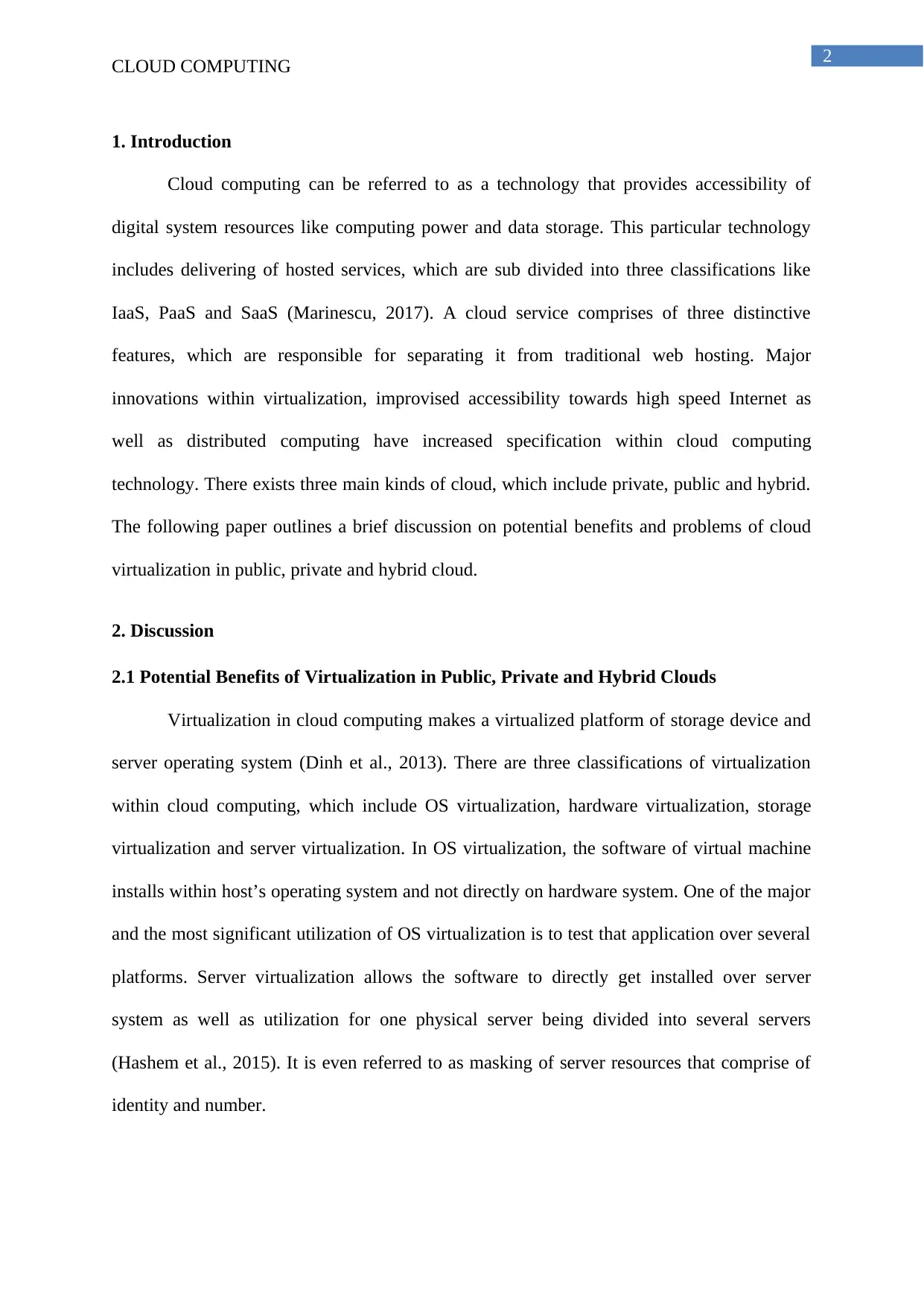
2
CLOUD COMPUTING
1. Introduction
Cloud computing can be referred to as a technology that provides accessibility of
digital system resources like computing power and data storage. This particular technology
includes delivering of hosted services, which are sub divided into three classifications like
IaaS, PaaS and SaaS (Marinescu, 2017). A cloud service comprises of three distinctive
features, which are responsible for separating it from traditional web hosting. Major
innovations within virtualization, improvised accessibility towards high speed Internet as
well as distributed computing have increased specification within cloud computing
technology. There exists three main kinds of cloud, which include private, public and hybrid.
The following paper outlines a brief discussion on potential benefits and problems of cloud
virtualization in public, private and hybrid cloud.
2. Discussion
2.1 Potential Benefits of Virtualization in Public, Private and Hybrid Clouds
Virtualization in cloud computing makes a virtualized platform of storage device and
server operating system (Dinh et al., 2013). There are three classifications of virtualization
within cloud computing, which include OS virtualization, hardware virtualization, storage
virtualization and server virtualization. In OS virtualization, the software of virtual machine
installs within host’s operating system and not directly on hardware system. One of the major
and the most significant utilization of OS virtualization is to test that application over several
platforms. Server virtualization allows the software to directly get installed over server
system as well as utilization for one physical server being divided into several servers
(Hashem et al., 2015). It is even referred to as masking of server resources that comprise of
identity and number.
CLOUD COMPUTING
1. Introduction
Cloud computing can be referred to as a technology that provides accessibility of
digital system resources like computing power and data storage. This particular technology
includes delivering of hosted services, which are sub divided into three classifications like
IaaS, PaaS and SaaS (Marinescu, 2017). A cloud service comprises of three distinctive
features, which are responsible for separating it from traditional web hosting. Major
innovations within virtualization, improvised accessibility towards high speed Internet as
well as distributed computing have increased specification within cloud computing
technology. There exists three main kinds of cloud, which include private, public and hybrid.
The following paper outlines a brief discussion on potential benefits and problems of cloud
virtualization in public, private and hybrid cloud.
2. Discussion
2.1 Potential Benefits of Virtualization in Public, Private and Hybrid Clouds
Virtualization in cloud computing makes a virtualized platform of storage device and
server operating system (Dinh et al., 2013). There are three classifications of virtualization
within cloud computing, which include OS virtualization, hardware virtualization, storage
virtualization and server virtualization. In OS virtualization, the software of virtual machine
installs within host’s operating system and not directly on hardware system. One of the major
and the most significant utilization of OS virtualization is to test that application over several
platforms. Server virtualization allows the software to directly get installed over server
system as well as utilization for one physical server being divided into several servers
(Hashem et al., 2015). It is even referred to as masking of server resources that comprise of
identity and number.
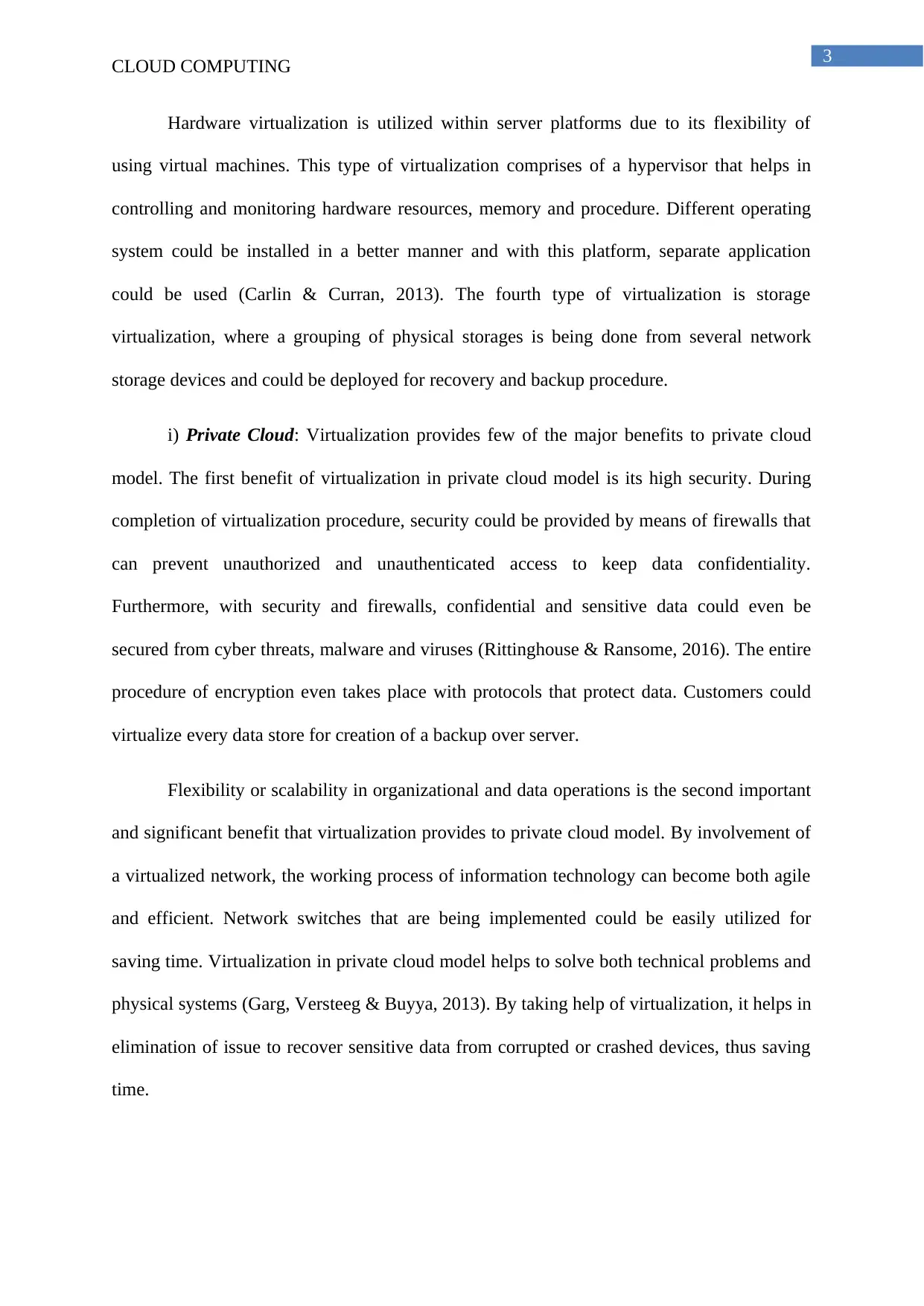
3
CLOUD COMPUTING
Hardware virtualization is utilized within server platforms due to its flexibility of
using virtual machines. This type of virtualization comprises of a hypervisor that helps in
controlling and monitoring hardware resources, memory and procedure. Different operating
system could be installed in a better manner and with this platform, separate application
could be used (Carlin & Curran, 2013). The fourth type of virtualization is storage
virtualization, where a grouping of physical storages is being done from several network
storage devices and could be deployed for recovery and backup procedure.
i) Private Cloud: Virtualization provides few of the major benefits to private cloud
model. The first benefit of virtualization in private cloud model is its high security. During
completion of virtualization procedure, security could be provided by means of firewalls that
can prevent unauthorized and unauthenticated access to keep data confidentiality.
Furthermore, with security and firewalls, confidential and sensitive data could even be
secured from cyber threats, malware and viruses (Rittinghouse & Ransome, 2016). The entire
procedure of encryption even takes place with protocols that protect data. Customers could
virtualize every data store for creation of a backup over server.
Flexibility or scalability in organizational and data operations is the second important
and significant benefit that virtualization provides to private cloud model. By involvement of
a virtualized network, the working process of information technology can become both agile
and efficient. Network switches that are being implemented could be easily utilized for
saving time. Virtualization in private cloud model helps to solve both technical problems and
physical systems (Garg, Versteeg & Buyya, 2013). By taking help of virtualization, it helps in
elimination of issue to recover sensitive data from corrupted or crashed devices, thus saving
time.
CLOUD COMPUTING
Hardware virtualization is utilized within server platforms due to its flexibility of
using virtual machines. This type of virtualization comprises of a hypervisor that helps in
controlling and monitoring hardware resources, memory and procedure. Different operating
system could be installed in a better manner and with this platform, separate application
could be used (Carlin & Curran, 2013). The fourth type of virtualization is storage
virtualization, where a grouping of physical storages is being done from several network
storage devices and could be deployed for recovery and backup procedure.
i) Private Cloud: Virtualization provides few of the major benefits to private cloud
model. The first benefit of virtualization in private cloud model is its high security. During
completion of virtualization procedure, security could be provided by means of firewalls that
can prevent unauthorized and unauthenticated access to keep data confidentiality.
Furthermore, with security and firewalls, confidential and sensitive data could even be
secured from cyber threats, malware and viruses (Rittinghouse & Ransome, 2016). The entire
procedure of encryption even takes place with protocols that protect data. Customers could
virtualize every data store for creation of a backup over server.
Flexibility or scalability in organizational and data operations is the second important
and significant benefit that virtualization provides to private cloud model. By involvement of
a virtualized network, the working process of information technology can become both agile
and efficient. Network switches that are being implemented could be easily utilized for
saving time. Virtualization in private cloud model helps to solve both technical problems and
physical systems (Garg, Versteeg & Buyya, 2013). By taking help of virtualization, it helps in
elimination of issue to recover sensitive data from corrupted or crashed devices, thus saving
time.
Secure Best Marks with AI Grader
Need help grading? Try our AI Grader for instant feedback on your assignments.
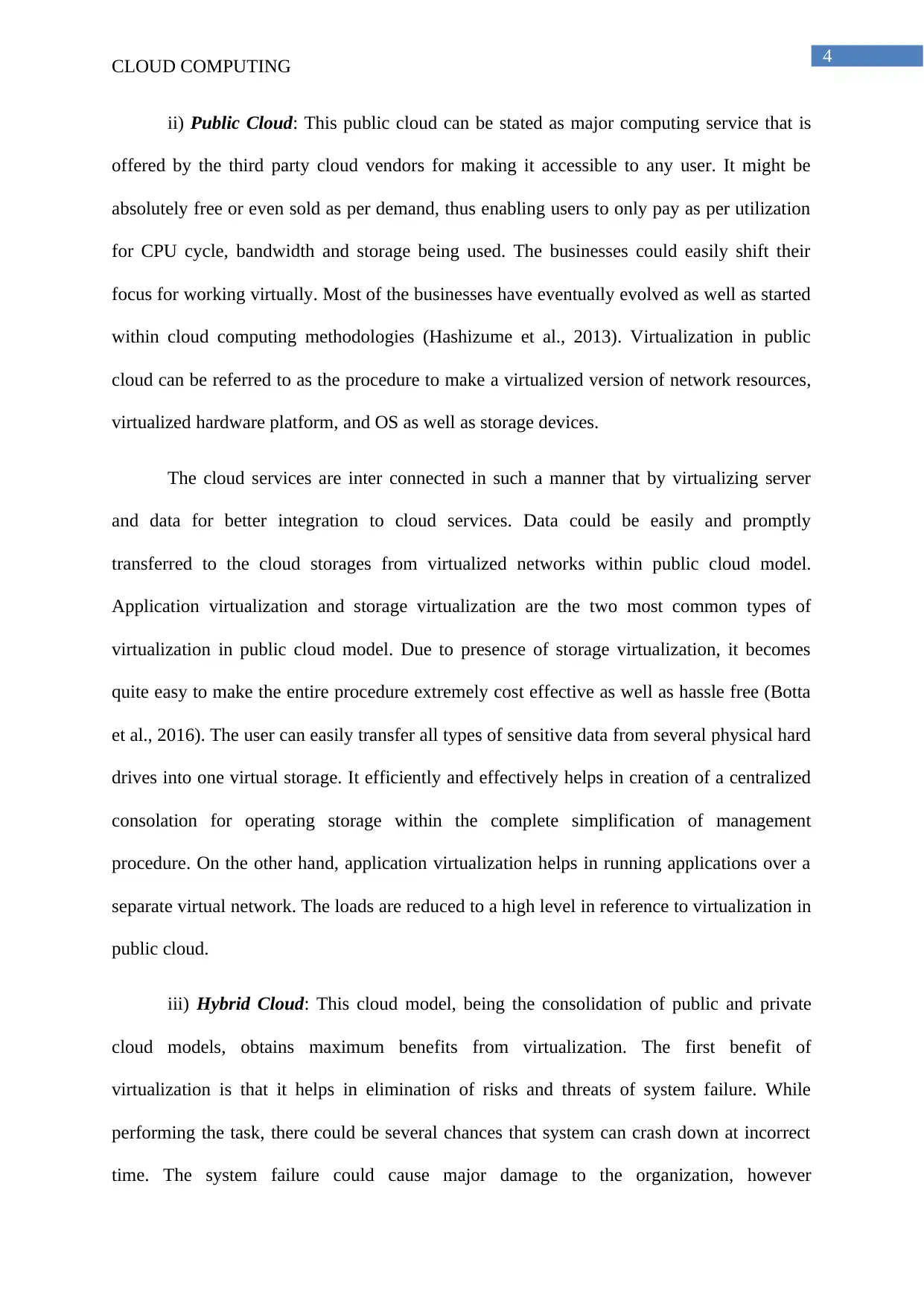
4
CLOUD COMPUTING
ii) Public Cloud: This public cloud can be stated as major computing service that is
offered by the third party cloud vendors for making it accessible to any user. It might be
absolutely free or even sold as per demand, thus enabling users to only pay as per utilization
for CPU cycle, bandwidth and storage being used. The businesses could easily shift their
focus for working virtually. Most of the businesses have eventually evolved as well as started
within cloud computing methodologies (Hashizume et al., 2013). Virtualization in public
cloud can be referred to as the procedure to make a virtualized version of network resources,
virtualized hardware platform, and OS as well as storage devices.
The cloud services are inter connected in such a manner that by virtualizing server
and data for better integration to cloud services. Data could be easily and promptly
transferred to the cloud storages from virtualized networks within public cloud model.
Application virtualization and storage virtualization are the two most common types of
virtualization in public cloud model. Due to presence of storage virtualization, it becomes
quite easy to make the entire procedure extremely cost effective as well as hassle free (Botta
et al., 2016). The user can easily transfer all types of sensitive data from several physical hard
drives into one virtual storage. It efficiently and effectively helps in creation of a centralized
consolation for operating storage within the complete simplification of management
procedure. On the other hand, application virtualization helps in running applications over a
separate virtual network. The loads are reduced to a high level in reference to virtualization in
public cloud.
iii) Hybrid Cloud: This cloud model, being the consolidation of public and private
cloud models, obtains maximum benefits from virtualization. The first benefit of
virtualization is that it helps in elimination of risks and threats of system failure. While
performing the task, there could be several chances that system can crash down at incorrect
time. The system failure could cause major damage to the organization, however
CLOUD COMPUTING
ii) Public Cloud: This public cloud can be stated as major computing service that is
offered by the third party cloud vendors for making it accessible to any user. It might be
absolutely free or even sold as per demand, thus enabling users to only pay as per utilization
for CPU cycle, bandwidth and storage being used. The businesses could easily shift their
focus for working virtually. Most of the businesses have eventually evolved as well as started
within cloud computing methodologies (Hashizume et al., 2013). Virtualization in public
cloud can be referred to as the procedure to make a virtualized version of network resources,
virtualized hardware platform, and OS as well as storage devices.
The cloud services are inter connected in such a manner that by virtualizing server
and data for better integration to cloud services. Data could be easily and promptly
transferred to the cloud storages from virtualized networks within public cloud model.
Application virtualization and storage virtualization are the two most common types of
virtualization in public cloud model. Due to presence of storage virtualization, it becomes
quite easy to make the entire procedure extremely cost effective as well as hassle free (Botta
et al., 2016). The user can easily transfer all types of sensitive data from several physical hard
drives into one virtual storage. It efficiently and effectively helps in creation of a centralized
consolation for operating storage within the complete simplification of management
procedure. On the other hand, application virtualization helps in running applications over a
separate virtual network. The loads are reduced to a high level in reference to virtualization in
public cloud.
iii) Hybrid Cloud: This cloud model, being the consolidation of public and private
cloud models, obtains maximum benefits from virtualization. The first benefit of
virtualization is that it helps in elimination of risks and threats of system failure. While
performing the task, there could be several chances that system can crash down at incorrect
time. The system failure could cause major damage to the organization, however
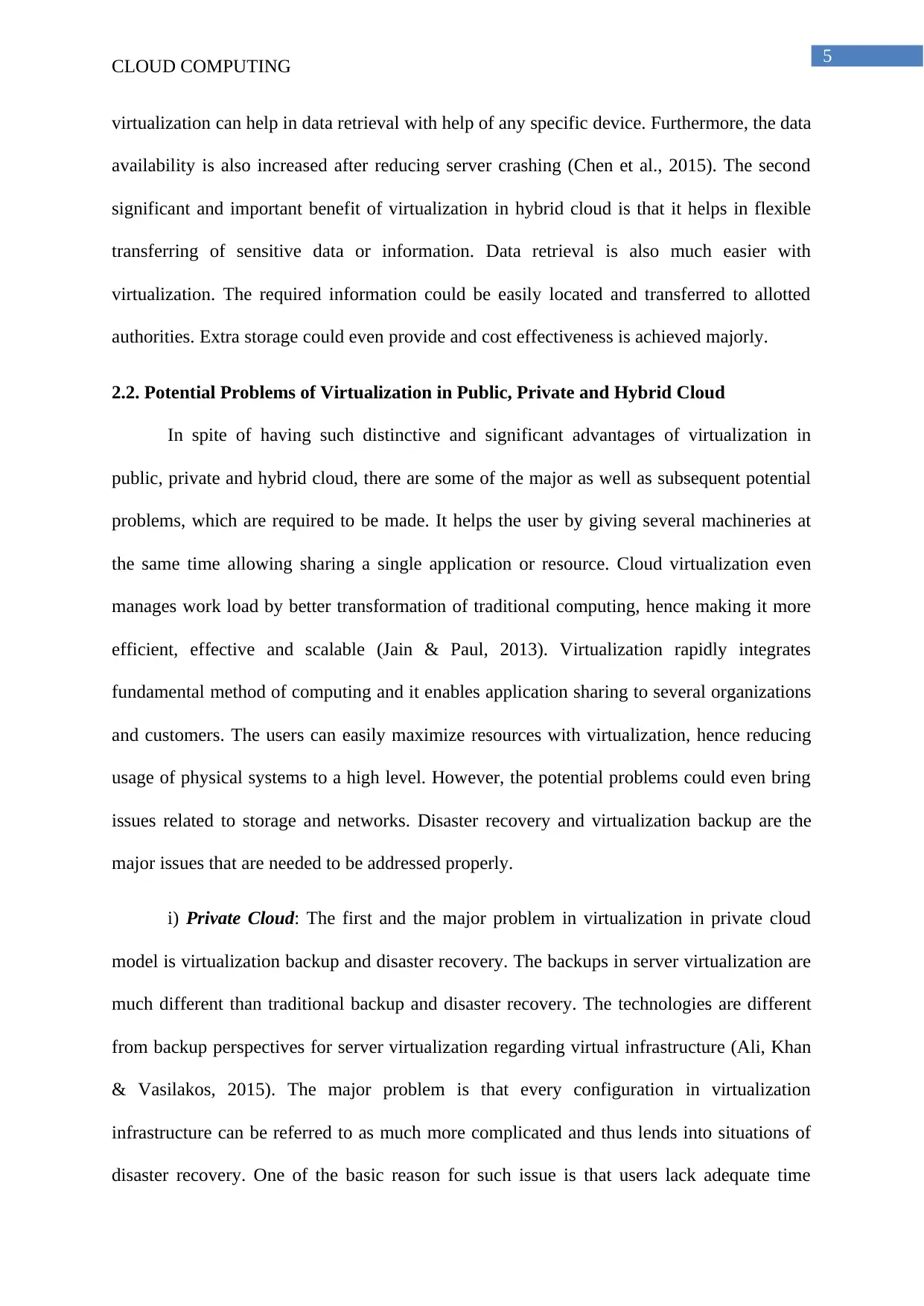
5
CLOUD COMPUTING
virtualization can help in data retrieval with help of any specific device. Furthermore, the data
availability is also increased after reducing server crashing (Chen et al., 2015). The second
significant and important benefit of virtualization in hybrid cloud is that it helps in flexible
transferring of sensitive data or information. Data retrieval is also much easier with
virtualization. The required information could be easily located and transferred to allotted
authorities. Extra storage could even provide and cost effectiveness is achieved majorly.
2.2. Potential Problems of Virtualization in Public, Private and Hybrid Cloud
In spite of having such distinctive and significant advantages of virtualization in
public, private and hybrid cloud, there are some of the major as well as subsequent potential
problems, which are required to be made. It helps the user by giving several machineries at
the same time allowing sharing a single application or resource. Cloud virtualization even
manages work load by better transformation of traditional computing, hence making it more
efficient, effective and scalable (Jain & Paul, 2013). Virtualization rapidly integrates
fundamental method of computing and it enables application sharing to several organizations
and customers. The users can easily maximize resources with virtualization, hence reducing
usage of physical systems to a high level. However, the potential problems could even bring
issues related to storage and networks. Disaster recovery and virtualization backup are the
major issues that are needed to be addressed properly.
i) Private Cloud: The first and the major problem in virtualization in private cloud
model is virtualization backup and disaster recovery. The backups in server virtualization are
much different than traditional backup and disaster recovery. The technologies are different
from backup perspectives for server virtualization regarding virtual infrastructure (Ali, Khan
& Vasilakos, 2015). The major problem is that every configuration in virtualization
infrastructure can be referred to as much more complicated and thus lends into situations of
disaster recovery. One of the basic reason for such issue is that users lack adequate time
CLOUD COMPUTING
virtualization can help in data retrieval with help of any specific device. Furthermore, the data
availability is also increased after reducing server crashing (Chen et al., 2015). The second
significant and important benefit of virtualization in hybrid cloud is that it helps in flexible
transferring of sensitive data or information. Data retrieval is also much easier with
virtualization. The required information could be easily located and transferred to allotted
authorities. Extra storage could even provide and cost effectiveness is achieved majorly.
2.2. Potential Problems of Virtualization in Public, Private and Hybrid Cloud
In spite of having such distinctive and significant advantages of virtualization in
public, private and hybrid cloud, there are some of the major as well as subsequent potential
problems, which are required to be made. It helps the user by giving several machineries at
the same time allowing sharing a single application or resource. Cloud virtualization even
manages work load by better transformation of traditional computing, hence making it more
efficient, effective and scalable (Jain & Paul, 2013). Virtualization rapidly integrates
fundamental method of computing and it enables application sharing to several organizations
and customers. The users can easily maximize resources with virtualization, hence reducing
usage of physical systems to a high level. However, the potential problems could even bring
issues related to storage and networks. Disaster recovery and virtualization backup are the
major issues that are needed to be addressed properly.
i) Private Cloud: The first and the major problem in virtualization in private cloud
model is virtualization backup and disaster recovery. The backups in server virtualization are
much different than traditional backup and disaster recovery. The technologies are different
from backup perspectives for server virtualization regarding virtual infrastructure (Ali, Khan
& Vasilakos, 2015). The major problem is that every configuration in virtualization
infrastructure can be referred to as much more complicated and thus lends into situations of
disaster recovery. One of the basic reason for such issue is that users lack adequate time
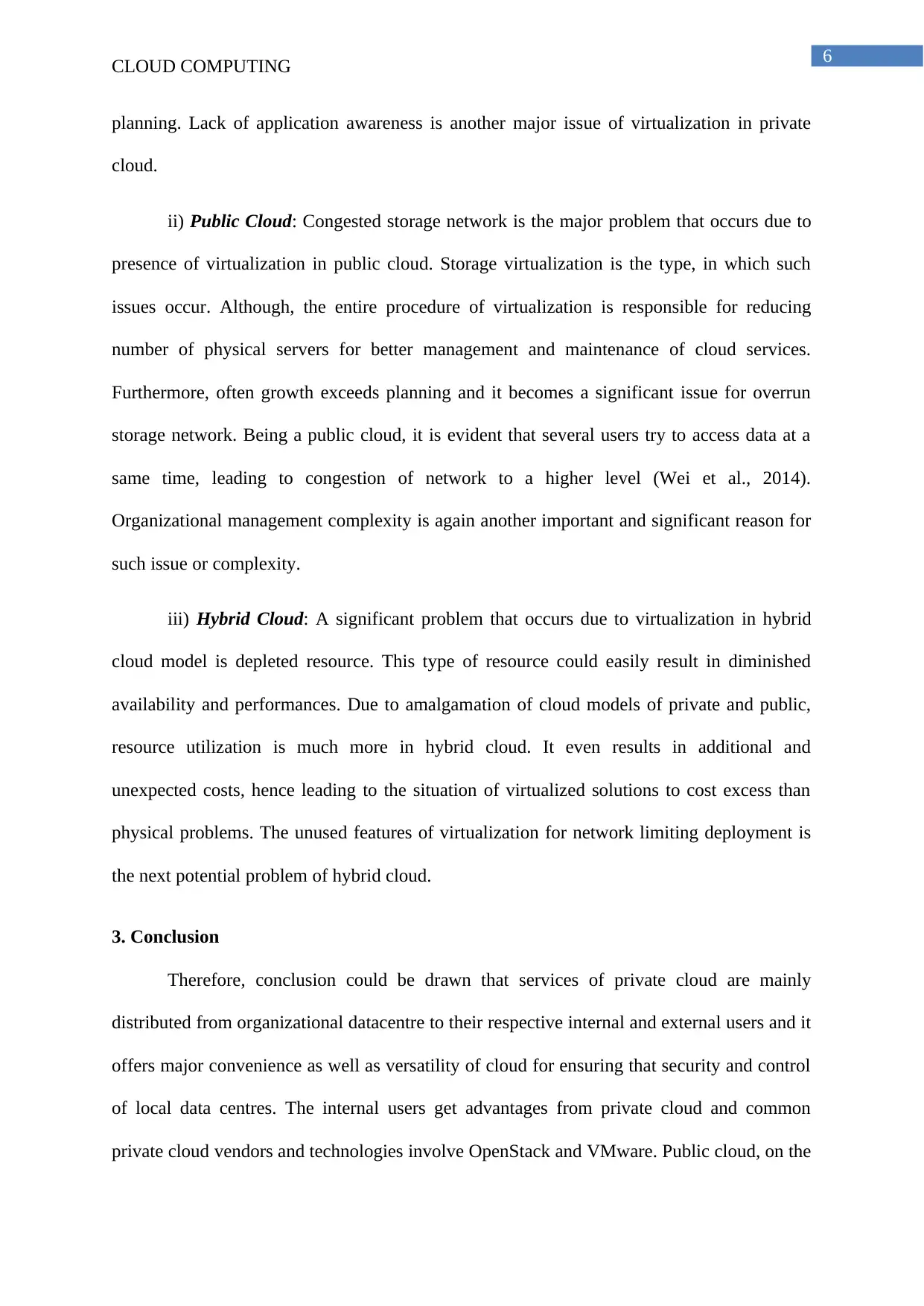
6
CLOUD COMPUTING
planning. Lack of application awareness is another major issue of virtualization in private
cloud.
ii) Public Cloud: Congested storage network is the major problem that occurs due to
presence of virtualization in public cloud. Storage virtualization is the type, in which such
issues occur. Although, the entire procedure of virtualization is responsible for reducing
number of physical servers for better management and maintenance of cloud services.
Furthermore, often growth exceeds planning and it becomes a significant issue for overrun
storage network. Being a public cloud, it is evident that several users try to access data at a
same time, leading to congestion of network to a higher level (Wei et al., 2014).
Organizational management complexity is again another important and significant reason for
such issue or complexity.
iii) Hybrid Cloud: A significant problem that occurs due to virtualization in hybrid
cloud model is depleted resource. This type of resource could easily result in diminished
availability and performances. Due to amalgamation of cloud models of private and public,
resource utilization is much more in hybrid cloud. It even results in additional and
unexpected costs, hence leading to the situation of virtualized solutions to cost excess than
physical problems. The unused features of virtualization for network limiting deployment is
the next potential problem of hybrid cloud.
3. Conclusion
Therefore, conclusion could be drawn that services of private cloud are mainly
distributed from organizational datacentre to their respective internal and external users and it
offers major convenience as well as versatility of cloud for ensuring that security and control
of local data centres. The internal users get advantages from private cloud and common
private cloud vendors and technologies involve OpenStack and VMware. Public cloud, on the
CLOUD COMPUTING
planning. Lack of application awareness is another major issue of virtualization in private
cloud.
ii) Public Cloud: Congested storage network is the major problem that occurs due to
presence of virtualization in public cloud. Storage virtualization is the type, in which such
issues occur. Although, the entire procedure of virtualization is responsible for reducing
number of physical servers for better management and maintenance of cloud services.
Furthermore, often growth exceeds planning and it becomes a significant issue for overrun
storage network. Being a public cloud, it is evident that several users try to access data at a
same time, leading to congestion of network to a higher level (Wei et al., 2014).
Organizational management complexity is again another important and significant reason for
such issue or complexity.
iii) Hybrid Cloud: A significant problem that occurs due to virtualization in hybrid
cloud model is depleted resource. This type of resource could easily result in diminished
availability and performances. Due to amalgamation of cloud models of private and public,
resource utilization is much more in hybrid cloud. It even results in additional and
unexpected costs, hence leading to the situation of virtualized solutions to cost excess than
physical problems. The unused features of virtualization for network limiting deployment is
the next potential problem of hybrid cloud.
3. Conclusion
Therefore, conclusion could be drawn that services of private cloud are mainly
distributed from organizational datacentre to their respective internal and external users and it
offers major convenience as well as versatility of cloud for ensuring that security and control
of local data centres. The internal users get advantages from private cloud and common
private cloud vendors and technologies involve OpenStack and VMware. Public cloud, on the
Paraphrase This Document
Need a fresh take? Get an instant paraphrase of this document with our AI Paraphraser
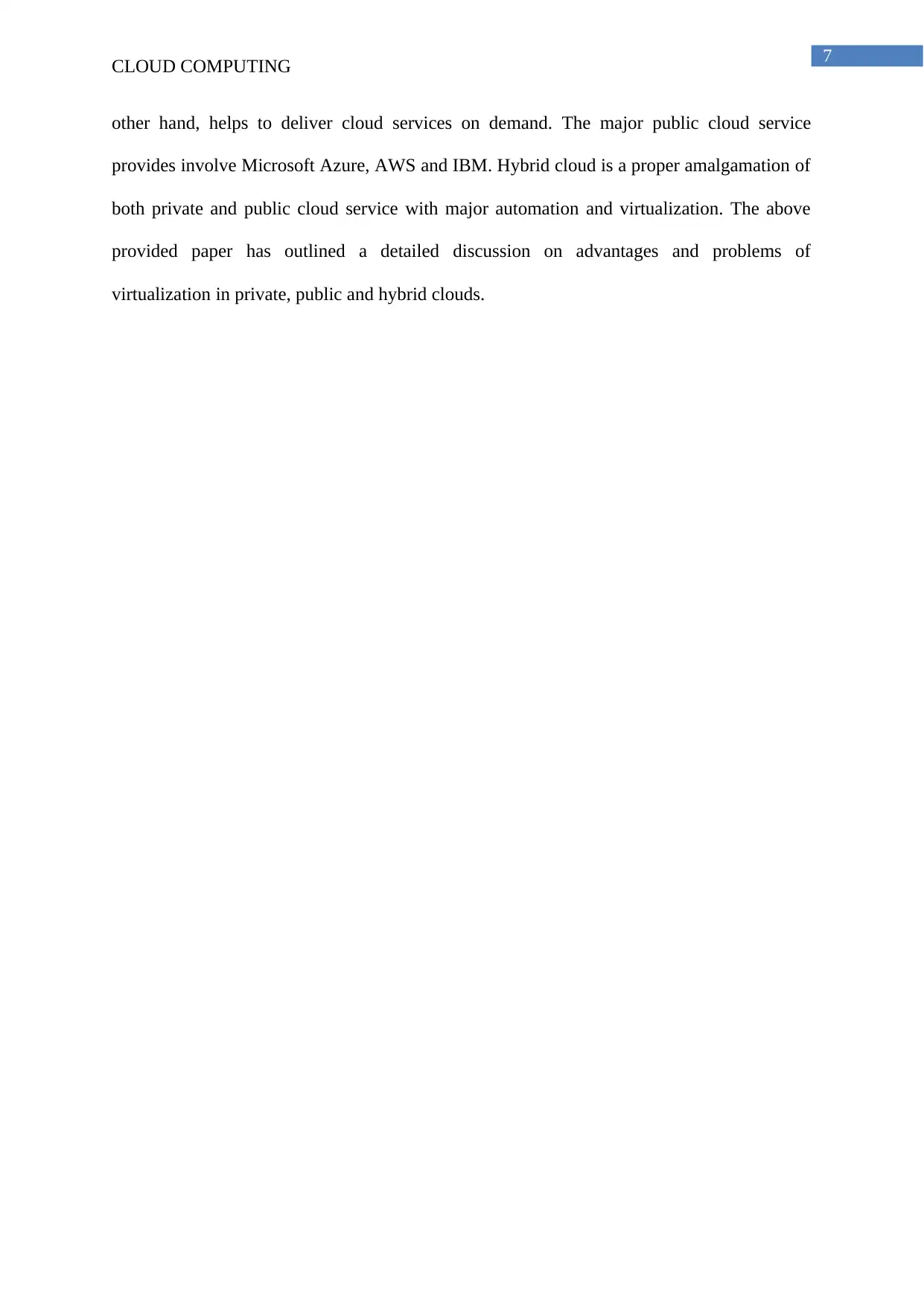
7
CLOUD COMPUTING
other hand, helps to deliver cloud services on demand. The major public cloud service
provides involve Microsoft Azure, AWS and IBM. Hybrid cloud is a proper amalgamation of
both private and public cloud service with major automation and virtualization. The above
provided paper has outlined a detailed discussion on advantages and problems of
virtualization in private, public and hybrid clouds.
CLOUD COMPUTING
other hand, helps to deliver cloud services on demand. The major public cloud service
provides involve Microsoft Azure, AWS and IBM. Hybrid cloud is a proper amalgamation of
both private and public cloud service with major automation and virtualization. The above
provided paper has outlined a detailed discussion on advantages and problems of
virtualization in private, public and hybrid clouds.
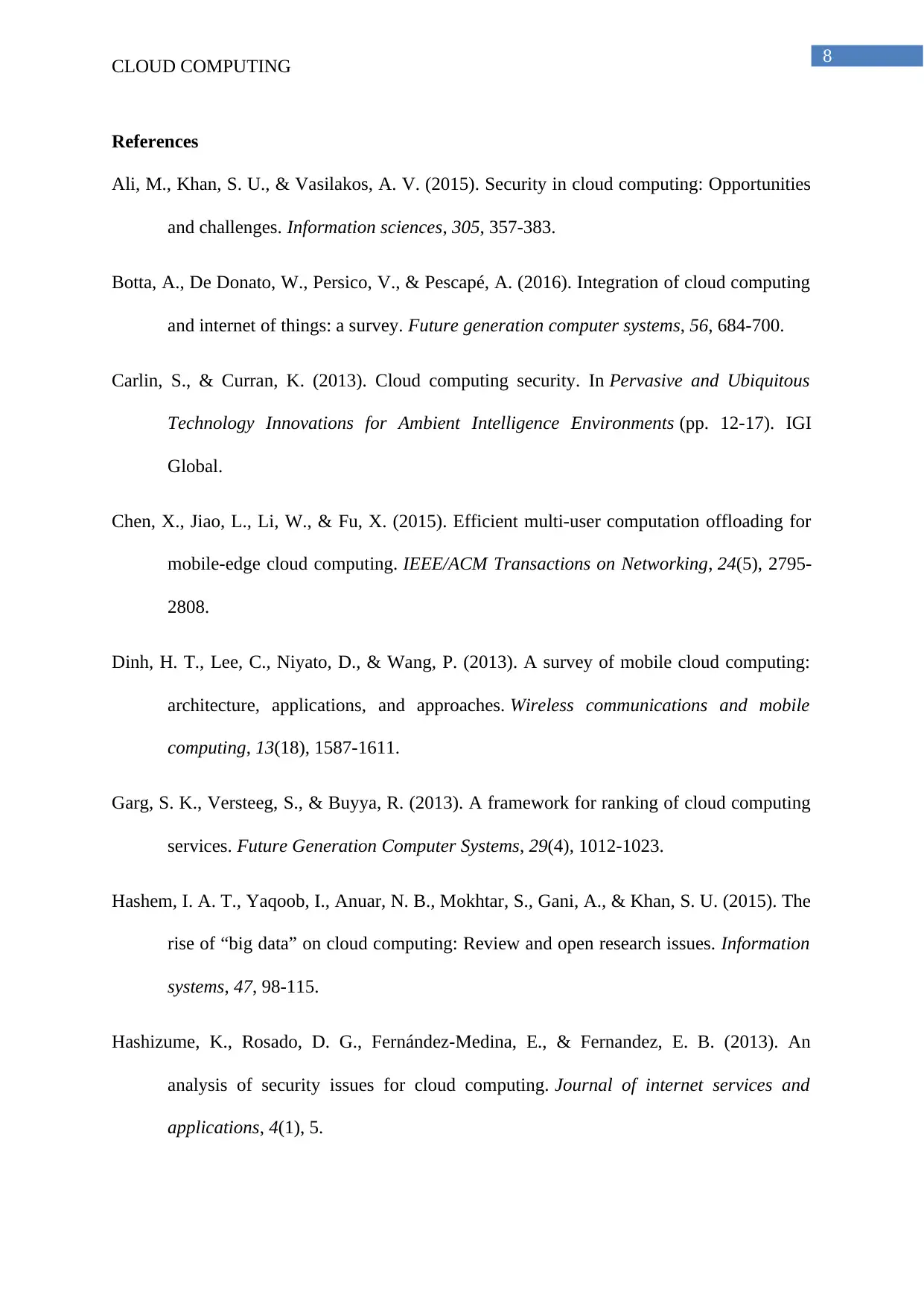
8
CLOUD COMPUTING
References
Ali, M., Khan, S. U., & Vasilakos, A. V. (2015). Security in cloud computing: Opportunities
and challenges. Information sciences, 305, 357-383.
Botta, A., De Donato, W., Persico, V., & Pescapé, A. (2016). Integration of cloud computing
and internet of things: a survey. Future generation computer systems, 56, 684-700.
Carlin, S., & Curran, K. (2013). Cloud computing security. In Pervasive and Ubiquitous
Technology Innovations for Ambient Intelligence Environments (pp. 12-17). IGI
Global.
Chen, X., Jiao, L., Li, W., & Fu, X. (2015). Efficient multi-user computation offloading for
mobile-edge cloud computing. IEEE/ACM Transactions on Networking, 24(5), 2795-
2808.
Dinh, H. T., Lee, C., Niyato, D., & Wang, P. (2013). A survey of mobile cloud computing:
architecture, applications, and approaches. Wireless communications and mobile
computing, 13(18), 1587-1611.
Garg, S. K., Versteeg, S., & Buyya, R. (2013). A framework for ranking of cloud computing
services. Future Generation Computer Systems, 29(4), 1012-1023.
Hashem, I. A. T., Yaqoob, I., Anuar, N. B., Mokhtar, S., Gani, A., & Khan, S. U. (2015). The
rise of “big data” on cloud computing: Review and open research issues. Information
systems, 47, 98-115.
Hashizume, K., Rosado, D. G., Fernández-Medina, E., & Fernandez, E. B. (2013). An
analysis of security issues for cloud computing. Journal of internet services and
applications, 4(1), 5.
CLOUD COMPUTING
References
Ali, M., Khan, S. U., & Vasilakos, A. V. (2015). Security in cloud computing: Opportunities
and challenges. Information sciences, 305, 357-383.
Botta, A., De Donato, W., Persico, V., & Pescapé, A. (2016). Integration of cloud computing
and internet of things: a survey. Future generation computer systems, 56, 684-700.
Carlin, S., & Curran, K. (2013). Cloud computing security. In Pervasive and Ubiquitous
Technology Innovations for Ambient Intelligence Environments (pp. 12-17). IGI
Global.
Chen, X., Jiao, L., Li, W., & Fu, X. (2015). Efficient multi-user computation offloading for
mobile-edge cloud computing. IEEE/ACM Transactions on Networking, 24(5), 2795-
2808.
Dinh, H. T., Lee, C., Niyato, D., & Wang, P. (2013). A survey of mobile cloud computing:
architecture, applications, and approaches. Wireless communications and mobile
computing, 13(18), 1587-1611.
Garg, S. K., Versteeg, S., & Buyya, R. (2013). A framework for ranking of cloud computing
services. Future Generation Computer Systems, 29(4), 1012-1023.
Hashem, I. A. T., Yaqoob, I., Anuar, N. B., Mokhtar, S., Gani, A., & Khan, S. U. (2015). The
rise of “big data” on cloud computing: Review and open research issues. Information
systems, 47, 98-115.
Hashizume, K., Rosado, D. G., Fernández-Medina, E., & Fernandez, E. B. (2013). An
analysis of security issues for cloud computing. Journal of internet services and
applications, 4(1), 5.
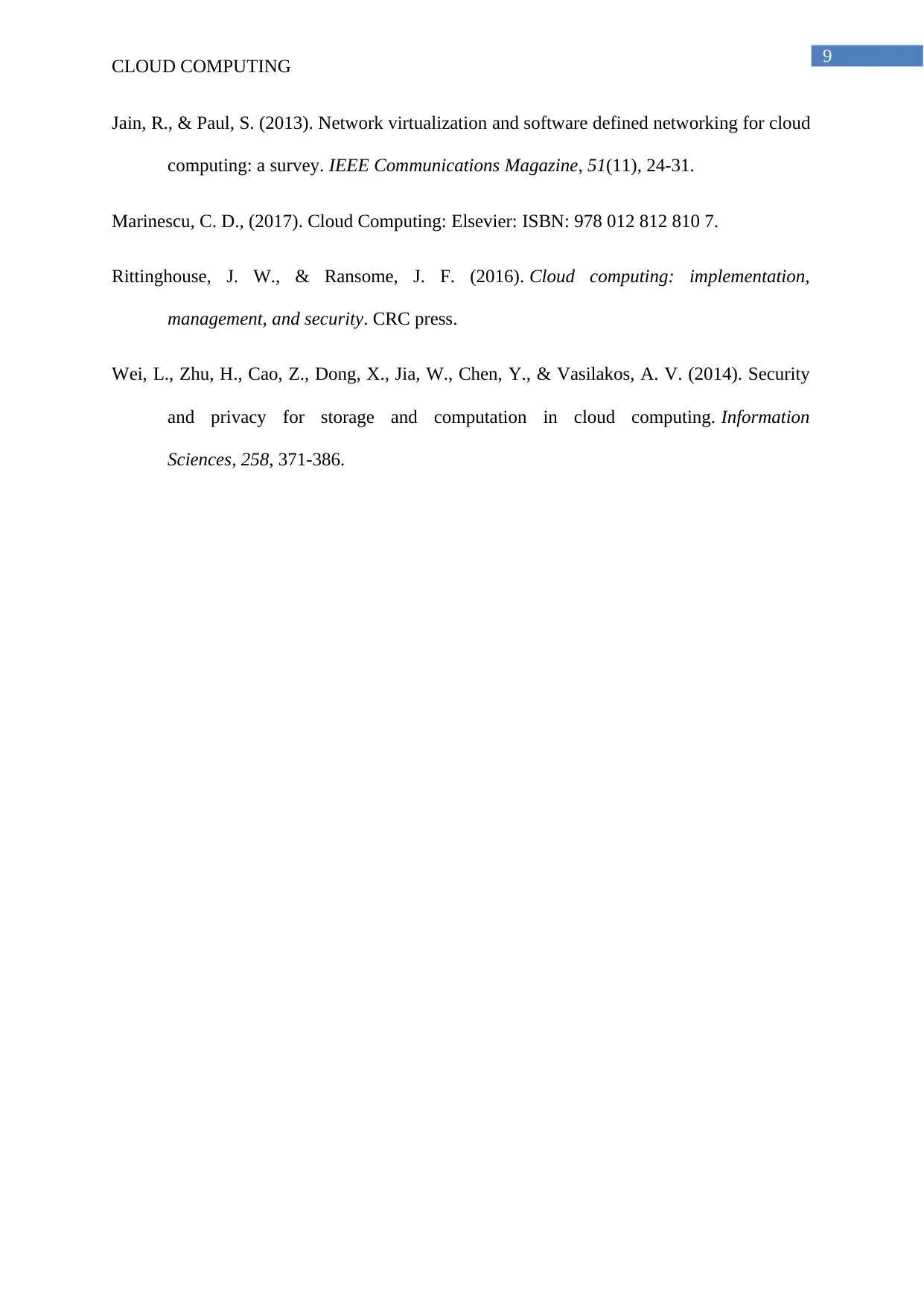
9
CLOUD COMPUTING
Jain, R., & Paul, S. (2013). Network virtualization and software defined networking for cloud
computing: a survey. IEEE Communications Magazine, 51(11), 24-31.
Marinescu, C. D., (2017). Cloud Computing: Elsevier: ISBN: 978 012 812 810 7.
Rittinghouse, J. W., & Ransome, J. F. (2016). Cloud computing: implementation,
management, and security. CRC press.
Wei, L., Zhu, H., Cao, Z., Dong, X., Jia, W., Chen, Y., & Vasilakos, A. V. (2014). Security
and privacy for storage and computation in cloud computing. Information
Sciences, 258, 371-386.
CLOUD COMPUTING
Jain, R., & Paul, S. (2013). Network virtualization and software defined networking for cloud
computing: a survey. IEEE Communications Magazine, 51(11), 24-31.
Marinescu, C. D., (2017). Cloud Computing: Elsevier: ISBN: 978 012 812 810 7.
Rittinghouse, J. W., & Ransome, J. F. (2016). Cloud computing: implementation,
management, and security. CRC press.
Wei, L., Zhu, H., Cao, Z., Dong, X., Jia, W., Chen, Y., & Vasilakos, A. V. (2014). Security
and privacy for storage and computation in cloud computing. Information
Sciences, 258, 371-386.
1 out of 10
Related Documents
Your All-in-One AI-Powered Toolkit for Academic Success.
+13062052269
info@desklib.com
Available 24*7 on WhatsApp / Email
![[object Object]](/_next/static/media/star-bottom.7253800d.svg)
Unlock your academic potential
© 2024 | Zucol Services PVT LTD | All rights reserved.





